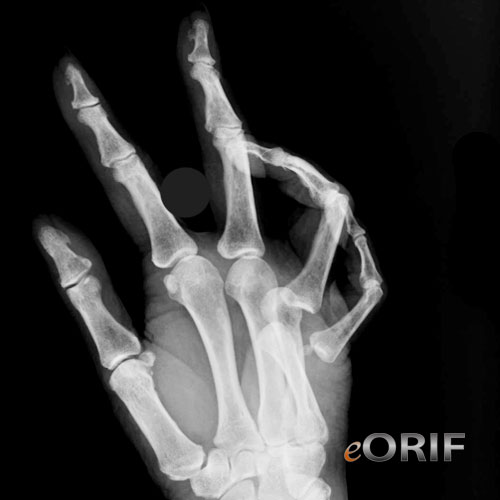|


|
synonyms:MCP dislocation
Metacarpophalageal Joint Dislocation ICD-10
- S63.114A Dislocation metacarpophalangeal joint right thumb, initial
- S63.115A Dislocation metacarpophalangeal joint left thumb, initial
- S63.260A Dislocation metacarpophalangeal joint right index finger, initial
- S63.261A Dislocation metacarpophalangeal joint left index finger, initial
- S63.262A Dislocation metacarpophalangeal joint right middle finger, initial
- S63.263A Dislocation metacarpophalangeal joint left middle finger, initial
- S63.264A Dislocation metacarpophalangeal joint right ring finger, initial
- S63.265A Dislocation metacarpophalangeal joint left ring finger, initial
- S63.267A Dislocation metacarpophalangeal joint left little finger, initial
- S63.266A Dislocation metacarpophalangeal joint right little finger, initial
A- initial encounter
D- subsequent encounter
S- sequela
Metacarpophalageal Joint Dislocation ICD-9
- 834.01 closed dislocation Metacarpophalageal Joint
- 834.11 open dislocation Metacarpophalageal Joint
Metacarpophalageal Joint Dislocation Etiology / Epidemiology / Natural History
- Generally caused by a fall on the outstretched hand causing forcible hyperextension of the MCP joint. Volar dislocations may result from hyperflexion injury.
- Dorsal dislocations >> volar dislocations5
- Index finger is most frequently involved, followed by the thumb.
- The volar plate is avulsed from its metacarpal neck attachment during dorsal dislocation and may become interposed within the joint preventing reduction. Other structures may also prevent reduction: lumbrical muscle, flexor tendons, natatory ligament, superficial transverse metacarpal ligament.
- Volar dislocations may be irreducible due to: dorsal capsule, distal insertion of the volar plate, collateral ligament, tendinous juncture connecting the fourth and fifth extensor digitorum communis tendons, dorsal
interosseous muscle, sesamoid bone.
Metacarpophalageal Joint Dislocation Anatomy
- Proper collateral ligaments are the primary stabilizers of the MCP joint: taut in flexion, lax in extension.
- Accessory collateral ligaments originate volar to the proper collateral ligaments and insert onto
the volar plate; taut in extension and lax in flexion.
- Volar plate: thick fibrocartilaginous portion distally and a looser, membranous portion proximally.
Metacarpophalageal Joint Dislocation Clinical Evaluation
Metacarpophalageal Joint Dislocation Xray / Diagnositc Tests
- A/P, lateral and oblique xrays of the hand demonstrate dislocation to the MCP joint.
Metacarpophalageal Joint Dislocation Classification / Treatment
- Complex dislocation: proximal phalanx nearly parallel with the metacarpal. Palmar plate, is entrapped in the MP joint. Requires open reduction. The palmar plate is incised longitudinally through its midline, allowing the metacarpal head to be reduced.
- Simple dorsal dislocation: proximal phalanx is nearly perpendicular to the joint. Reduction: wrist is flexed to allow relaxation of the flexor tendons. Distal traction as well as volar-directed pressure to the base of the proximal phalanx generally provides reduction of a simple dislocation.
-
Metacarpophalageal Joint Dislocation Associated Injuries / Differential Diagnosis
Metacarpophalageal Joint Dislocation Complications
Metacarpophalageal Joint Dislocation Follow-up Care
Metacarpophalageal Joint Dislocation Review References
- Dinh P, JAAOS; 2009 ; 17:318
- Becton JL, Christian JD Jr, Goodwin HN, Jackson JG 3rd. A simplified technique for treating the complex dislocation of the index metacarpophalangeal joint. J Bone Joint Surg Am. 1975 Jul;57(5):698-700.
- Green DP, Terry GC. Complex dislocation of the metacarpophalangeal joint. Correlative pathological anatomy. J Bone Joint Surg Am. 1973 Oct;55(7):1480-6.
|


